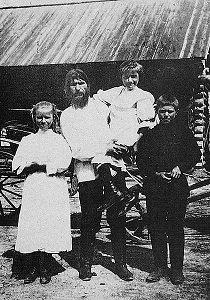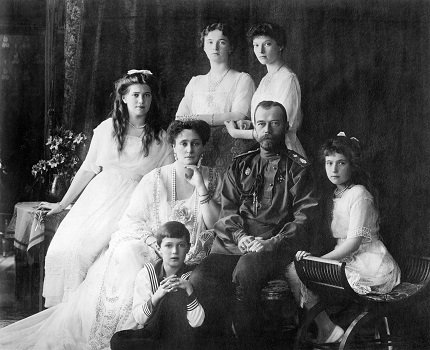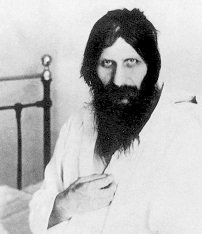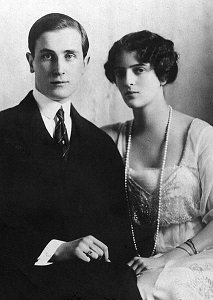Grigori Rasputin, Russian Mystic
Grigori Rasputin, the man who would be labelled by history as the dark genius at the heart of the Russian court, was born a simple peasant in the West Siberian plain in 1869. In another country his family would have been considered middle-class – his father was a local postmaster, and reasonably well off – but in Russia, a peasant was a peasant regardless of how well they did for themselves. As a result, despite his family’s income young Rasputin and his siblings had little or no formal schooling, and he was never taught to read and write. He was one of nine children, but only two survived to adulthood. Later writers claim that he never fit into the village, but it’s hard to know how much of that is true and how much is people looking back. Stories were told later (almost certainly fictitious) of the young Rasputin rising from his sickbed while the village was searching for a horse thief to denounce the guilty party, of him healing a sick child with a prayer and so forth. Rasputin himself claimed that his own health was rarely the best, and that this was often the subject for mockery by his fellow villagers.

In truth he seems to have led a somewhat prosaic life. He was married at the age of twenty to a woman a few years older, and they had at least five children. Of these two died as infants, and the generally accepted hypothesis is that it was one of these deaths that led Rasputin to go on a retreat in a local monastery. Another version is that entered the monastery as a teenager, and had left when he was nineteen to get married. This would explain his relatively late nuptials. However it happened, once he entered aged 24 he seemed to find his calling. There were two main influences that led Rasputin to permanently dedicate his life to the religious. The first was a hermit who lived near the monastery, named Brother Makary. Makary seems to have been an ascetic who practised “mortification of the flesh”, specifically the wearing of chains in order to remind himself of his own mortal frailty. He also seems to have had a strange kind of anti-theology, which was a popular strain of Orthodox Christianity at the time. He taught that faith should be accepted and unquestioned as the centre of existence. The second seems to have been some kind of vision or religious experience Rasputin himself had. This gnostic episode lit a match to his faith, and it became the burning centre of his life.
In 1893 Rasputin set out on a pilgrimage to Mount Athos, a peninsula in Greece that holds a position in Orthodox Christianity almost like that of the Vatican in the Catholic faith (minus the Pope). [1] Though the trip itself and the monasteries of Mount Athos failed to impress Rasputin, the fact that he had made the trip certainly impressed his compatriots. He gained a reputation as a holy wanderer, like an itinerant friar in medieval Europe. His undoubted intelligence (despite his lack of formal training) received a lot of respect, and over the next decade he gained a loyal following in the surrounding area. He still returned home for the working seasons, though, and remained close to his children and wife. By 1903 he had visited both Kiev and Kazan, where he impressed the other churchmen he met with his grasp of theology and keen insights. In 1905 he travelled to St Petersburg, which was the capital of Russia at the time, in order to solicit donations for his church. His spiritual nature fit in with the fashion at the time, and he became a popular houseguest. He was an especial favourite of the two sisters Milica and Anastasia, princesses of Montenegro who had become Grand Duchesses of Russia when they married a pair of Russian brothers from the royal family. It was Milica who in November 1905 first introduced Rasputin to the Tsar, Nicholas II.

Much has been made of Rasputin’s first meeting with the royal family, but little of it appears to have any basis in fact. It did serve as a marker of his acceptance in the court, and he gained a reputation as a great mystic and healer. Still, it was a year and a half later that the royal family asked him to visit the young Tsarivich Alexei. Alexei suffered from haemophilia, a genetic disorder that prevents the proper clotting of the blood and for which there was no treatment at the time. The disorder had two main effects – the first being constant joint pain. The second was a chance for any wound, no matter how trivial, to become life threatening. It was one such wound in March 1907 that prompted the royals to send for Rasputin, in the faint hope that he would be able to help the boy. Astonishingly, it seems that he could. Exactly how he was able to do so is unknown. There is no evidence that he hypnotised the boy, as some would later claim. The most prosaic explanation is that his presence prevented the doctors from treating the boy with pain medication, which at that time meant aspirin. Aspirin acts as a blood thinner, and so it could be that by giving it to Alexei the doctors were unwittingly worsening his condition dramatically. Regardless of the explanation however, it was the results that mattered. Alexei made a recovery, and Rasputin received the credit. The Tsar was grateful and the Tsarina, Alexandra, was convinced that Rasputin had been sent by God in answer to her prayers.
There are those who point to this as the beginning of the end for Imperial Russia. To say this is absurd is to understate it somewhat. The root of the myth that Rasputin “corrupted the royal family” comes from the Tsarina’s appreciation of his effect on Alexei. There were plenty at court who disagreed with the Tsarina on matters of policy. She was German by birth (and a granddaughter of Queen Victoria, which is almost certainly where her carrier genes for haemophilia originated). Naturally her advice to the Tsar on foreign policy tended to sympathise with her birth country. Those who opposed this were in a tricky position. To oppose the royal family directly was possibly treasonous, and certainly unwise. So they used the same tactic that had been used in this situation for centuries. They went after those close to the family, and claimed that they must be “leading them astray”. And who easier to attack than a peasant of dubious religious affiliation?

Rasputin was popular with the people at first. He was one of them, his religion was the religion of the masses rather than that of the bishops in palaces. The rumours that began to circulate first attacked his religious orthodoxy. He was accused of being a Khlyst, a member of an underground sect of heretics. Their actual practises are a bit of a mystery, and from what is described they may merely have been a Presbyterian-like rejection of the orthodox church’s hierarchy combined with Baptist-style worship practises. In the popular imagination however they were accused of believing in “salvation through sin”, and practised both self-flagellation and orgies. There’s no evidence that this was true, [1] and there is definite evidence that Rasputin wasn’t a Khlyst (he was investigated several times by the church, who cleared him of the charge). Yet even today apparently reputable sources repeat both that Rasputin was a Khlyst, and that he was thus a sex maniac. With three children he was definitely not chaste, and may not have been faithful to his wife, but given the microscope he was put under by the Tsarina’s enemies it’s impossible to believe he could have lived the life of debauchery that legend gives him.
Regardless of the truth of the accusations, enough people believed them that a campaign began to exile him from the capital. In 1911 the Tsar (who always dismissed the complaints against Rasputin as “tittle-tattle”) told him to go on a pilgrimage, in the hope that his absence would cool the rumours. Rasputin first visited Pochayiv Lavra, the monastery that served as the spiritual centre of the Ukraine. He went on to visit Istanbul (formerly Constantinople), Patmos and eventually Jerusalem and the Holy Land. The trip didn’t have the hoped for effect, and in 1912 the Prime Minister, Count Vladimir Kokovtsov, formally asked the Tsar for permission to exile Rasputin. (He may also have passed on the rumours that Rasputin was having an affair with the Tsarina and/or her daughters, which he had forbidden the press to publish.) The Tsar refused the request. Kokovstov offered Rasputin a gigantic bribe to leave the capital, but he would not accept it. The Prime Minister’s influence did push Rasputin out of favour for a while, but he was restored in October of that year when Alexei injured himself getting into a rowing boat. The injury reopened on a carriage ride, and matters became so serious that his death seemed imminent. Rasputin sent a reassuring telegram (that included an exhortation to not “allow the doctors to bother him too much”), and when Alexei did recover the Imperial family treated his words as prophecy.

It was July 1914 that the first attempt to murder Rasputin took place. The attempt took place during a visit he made to his home town. The would be assassin, a woman named Khioniya Guseva, attacked him with a knife after he had been drawn out onto the street by a false telegram. She stabbed him in the stomach, then chased him as he fled down the street. The local people (who still supported Rasputin, even if nobody else did) leapt to his defence, and Khioniya was nearly lynched before the police could arrest her. Rasputin was severely injured, and spent six weeks in hospital undergoing multiple surgeries to save his life. The Tsar’s personal physician was sent to treat him. Khioniya Guseva was determined by the courts to be insane, and sent to an asylum. [2] Rasputin was convinced that she had been set up to kill him by the Archimandrite Iliodor, a prominent Russian monk who had once been his friend and ally. Iliodor had turned against Rasputin in recent years, and had reportedly been the one who gave Kokovstov the “proof” of Rasputin and the Tsarina’s affair.
Shortly after this, World War I broke out and everything changed. Rasputin, as a noted pacifist, urged the Tsar not to get drawn into the war. This, combined with the Tsarina’s German heritage and his closeness to her, convinced the other Allies and the hawkish Russian politicians that Rasputin was a serious threat to the war effort. The secret police began tracking Rasputin, and reports were forwarded to the Tsar to prove his depravity. The Tsar pointed out that on one of the occasions listed, Rasputin had actually been visiting the royal family. There are rumours that Rasputin’s opponents had marshaled a set of lookalikes to cause trouble and blacken his reputation, though this seems unlikely. The situation became (in the eyes of his enemies) even more dire when the Tsar left the capital and went to the front with Germany to personally take charge of the war effort. This left the Tsarina as ruler of the capital, which to them was as good as ceding power to Rasputin. As the scale of the war, and the casualties, began to bite home in 1915 the public turned on all foreigners. The lack of basic foodstuffs caused by the demands of the war and the reduced workforce in the fields didn’t help. There were open street protests demanding the Tsarina be exiled to a convent, and the civic unrest that would lead to the oncoming revolutions was coalescing.

Elements of the Russian government had by 1916 became convinced (almost certainly incorrectly) that Rasputin was a spy for the Germans. In November 1916 the ultra-rightwing politician Vladimir Purishkevich gave a speech to the Duma denouncing “the evil genius of Russia” Rasputin and the “German on the Russian throne” Tsarina. He compared Rasputin to False Dmitry and ended with the ominous declaration:
While Rasputin is alive, we cannot win.
Prince Felix Yusupov, a staunch supporter of the Allies who had been to university in England [3] was impressed by the speech and approached Purishkevich to see if he was willing to put his words into action. Felix made contact with the Tsar’s cousin Grand Duke Dmitri Pavlovich, to ensure that the murder would not be taken as a revolutionary act. Dmitri became an active part of planning the murder. The night of the 29th December, 1916, was chosen as the day for the fateful deed. [4]
The exact details of what happened that night have become mythologised to the point of almost complete obscurity. Both Purishkevich and Prince Felix have given their account of the night, but neither has been consistent (with each other, or even with themselves) and both are pretty clearly biased. It’s indisputable that Rasputin was decoyed to the palace to attend a housewarming party, though the guests at the party remain largely undocumented. Felix’s account is that he fed Rasputin sweet dessert wines and pastries poisoned with cyanide, though they failed to take effect. Rasputin’s daughter Maria claimed this was unlikely, as since he had been stabbed her father had needed to avoid sugary foods. Felix’s account continues that the poison seemed to have no effect, so he shoot the unsuspecting Rasputin in the side. Rasputin collapsed, but then while the conspirators were debating how to dispose of the body he regained consciousness and fled the building, bleeding heavily. The noise he made alerted them, and they gave pursuit. Purishkevich fired at him four times across the palace courtyard, hitting him in the back and fatally wounding him. Despite the fact that he was either dead or dying, one of the conspirators then shot him in the centre of the forehead from point blank range to make sure. Two passing policemen heard the shots and came to investigate. At first they were fobbed off, but then Purishkevich invited one of them in and openly admitted to having just killed Rasputin, “for the good of Russia”. The policeman made a report of the conversation, but did not arrest anyone. The conspirators wrapped the body up and carried it out of the palace to a nearby bridge, where they disposed of it into the river through a hole in its frozen surface, where the river would carry it away. Or so they thought.

The legend of Rasputin has it that he was somehow still alive, and managed to crawl ashore before dying of hypothermia. It’s more likely that his waterproofed coat, bundled up in the cloth the assassins used, trapped enough air to prevent him from sinking beneath the ice. Instead it drifted to the shore, where it would be found a few days later. In the meantime Rasputin’s disappearance had prompted his daughters (who he had moved to the capital in the hopes of finding them a good marriage) were approached by the police and asked where there father was. They told of him being invited to the housewarming by Felix, and mentioned that he had said his wife would be there. Maria then told Anna Vyrubova, a friend of the Tsarina’s who had acted as a liaison between her and Rasputin. Anna had been crippled in a train accident the previous year, and credited Rasputin’s prayers with saving her life. She passed the story on to the Tsarina, who knew that Felix’s wife was out of the city. At her request the police went to interview Felix. They noticed a bloodstain on his back step, which he said was dog blood. (Police testing, of course, showed this to be false.) Both Felix and Purishkevich tried to meet with the Empress, but she refused to see them. The police discovered one of Rasputin’s boots on the bridge (where it had caught on the parapet) and searched around the river, finding the body at the river’s edge.
Rasputin was buried in a private ceremony on land owned by Anna Vyrubova. The Tsarina and her daughters attended, but the location was kept secret for fear the mob would desecrate the grave. The official investigation found itself unable to progress any further – they had no jurisdiction over imperial matters without invitation, and Felix’s father in law (the Tsar’s brother) used his influence to end the investigation. Felix and his father were sent into exile while Purishkevich left for the front, but no further action was taken against them. The Tsarina might have pushed for them to receive greater punishment, but the February Revolution in 1917 ended autocratic rule in Russia. The idea that removing Rasputin would save the country was revealed for the idiocy that it was. The new government wound up exhuming Rasputin’s body and sending it back to his home village. The truck they sent it on broke down and the driver, rather than abandon it, cremated the corpse. Within a year and a half that government had been overthrown by the Bolsheviks, and the entire Imperial family had been murdered and buried in an unmarked grave.
Rasputin became for many the symbol of the corruption and decadence that doomed Imperial Russia. His mysticism made him a target of scorn from the Bolsheviks, and his peasant origins made him a target for the Russians in exile. Purishkevich died in 1920 with the White Russian army, but Prince Felix fled to a comfortable exile in Paris. He openly boasted of his murder of Rasputin, which he regarded as a heroic act. In 1928 he published his memoirs, in which he glorified himself and demonised Rasputin. In response Rasputin’s daughter Maria (who had also managed to escape the Bolshevik net) sued him in a Paris court, seeking to claim civil damages for the murder he admitted to committing. The court ruled that it had no jurisdiction over a killing carried out abroad. Maria published her own memoirs, in which she tried to redeem her father’s reputation. This had little effect, though. The world preferred Rasputin as a villain.

Maria wound up trading on her reputation as the daughter of the “infamous Devil Monk” to join a circus, which took her across to America. There she wound up working as a riveter in the navy shipyards during World War 2 before becoming a US citizen in 1946. Her father’s legend continued to grow with the advent of the movie, as the sinister-looking Rasputin made for a distinctive antagonist, and the story now became that he was a devil-worshipping hypnotist, who proved almost impossible to kill. [5] Christopher Lee’s portrayal of him in the 1966 Hammer film Rasputin: The Mad Monk became the archetypal version of him, [6] and his name became a byword for sinister evil. (He also inspired a Boney M song, which described him as “Russia’s greatest love machine” who “ruled the Russian land and never mind the Tsar”.) Nowadays it’s almost impossible to find a portrayal of him that doesn’t follow this template. The real Rasputin may have been, as his daughter and friends described him, a gentle and spiritual man who only ever tried to do his best. Or he may have been a social climber, who took advantage of a credulous royal family to be the most successful of the charlatans in the dying days of the Empire. The one thing he wasn’t is all he’s ever remembered as: a monster.
Images via wikimedia except where stated.
[1] Most of the accusations against the Khlyst (including that they sacrificed children) have been deployed against any and all unorthodox religious practitioners for millenia, including Jews and even early Christians.
[2] In 1917 she was released on the order of the Minister for Justice of the “White Russian” government, following the first revolution. In 191 she was arrested again after attempting to assassinate the Patriach Tikhon, head of the Russian Orthodox church.
[3] In fact, like several members of the current British government he was a member of the Bullingdon Club.
[4] Those dates are on the Julian calendar, which remained in use in Russia until 1918. The Gregorian equivalent was the 16th December, which leads to some confusion in accounts.
[5] One such movie, made by MGM in 1932, actually caused Prince Felix to sue (and win). His objection was not to his own portrayal, but rather that it showed Rasputin seducing his wife.
[6] Lee actually met Prince Felix once when he was a child, as the fleeing Prince knew his mother (an Italian Countess).
